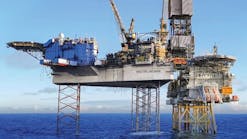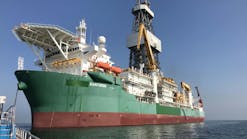Frank Hartley • Houston
Offshore fracturing fluid
Starting with a basic guar polymer similar to that used as a thickening agent for foods such as hot sauce and ice cream, Baker Oil Tools has developed a fracturing fluid it says is the first to combine performance with benign environmental effects such as low toxicity and biodegradability.
The fluid meets and exceeds current Gulf of Mexico offshore permitted waste fluid discharge regulations for "well treatment fluid" standards set by the Environmental Prot-ection Agency, specified in the Code of Federal Regulations, 40 CFR Part 435. With less than 29 mg/l of hexane extractable material oil and grease content, it satisfies the EPA's definition of "oil and gas free" for well treating fluids.
The EPA regulations do not establish a discharge permit standard for toxicity for well treatment fluids. However, with this fluid system's low toxicity (less than 3%), the fluid exceeds the 40 CFR Part 435 standards set for drilling fluids. The fluid biodegrades to more than 60% in 28 days as tested by the (OECD) guidelines, therefore, meeting or exceeding this standard.
The B9 Emerald FRAQ fracturing fluid is designed to combine performance with benign environmental effects such as low toxicity and biodegradability.
null
"The EPA regulatory classifications for offshore well treatment fluids do not specify a toxicity level or a requirement to be bio-degradable, but the industry wants to satisfy both the letter and the spirit of the regulations, and we want to help them accomplish that," said Rudy de Grood, Baker Oil Tools' Fluids Pumping Services Product Line Manager. He also added that he wanted a fluid that would enhance performance without incurring incremental costs.
Satisfying all of these criteria meant going outside the bounds of conventional breaker technology and developing a completely new technology based on readily available chemicals found in everyday foods and cosmetics. The result, says Baker, is the first fracturing fluid to successfully combine superior performance with benign environmental effects.
By using the fluid, the company says, offshore operators can reduce the environmental impact of their frac pack completion operations. Equally important, the ability to discharge fluid under the well's site-specific discharge permit reduces disposal costs and risks associated with handling and transporting fluids.
Drillable drive shoe
BJ Tubular Services recently completed pile-driving services for Murphy Sarawak Oil Co. of Malaysia for its jackup-deployed platform installation off the west coast of Borneo. The project proved to be a real engineering and operational challenge. The four structure support piles, measuring 36-in. x 1.25-in., would also be used as conductors for the Production A platform in the West Patricia Field. Each of the four structure piles or conductors were to contain 3 x 13-3/8-in. casing strings, utilizing AB- STL flush connections depending on pipe weight. This configuration would serve as the basis of a 12-well platform. The four piles were made up using internally-externally flush Oil States Puma connections.
Murphy Oil Engineering determined that the required depth of penetration for the 36-in. piles would be from 72 to 75 m below the mudline. Using soil data provided and drive simulations, a decision to use a reduced (ID) drive shoe was made. This would reduce the potential for washing out the casing during driving to reach the required pile penetration. The drive shoe is normally constructed from steel and remains inside the tip of the pile after it is successfully driven into place.
However, due to the risk of connection interference and/or hang-up at the pile tip, Murphy Sarawak wanted a drillable drive shoe to avoid a permanent reduction in pile I.D. As an alternative to conventional approaches, it was decided to use an insert made of material other than steel that would perform the same function as a traditional drive shoe, but could be removed after pile driving was completed. Using the Composite Drillable Drive Shoe system (CDDS), would mitigate internal pile skin friction while driving and allow installation to be achieved with currently available equipment. After considering several different materials and methods of installation, sheets of 15-mm thick composite material that formed to suit the I.D. of the pipe was used. The composite was then bonded to the inner bore of the parent pipe.
Pile-driving simulations were presented to demonstrate the performance of the composite material insert in conjunction with the specialized Offshore Hydraulic Pile Driving System.
null
BJ designed inserts and constructed scale models before testing them to destruction to determine the shear potential of the bonding material. Murphy Sarawak agreed to the use of the removable composite material insert. The approach involved removing the insert after pile driving had been completed during the first pass of the drill bit, while the combined structure pile/ conductor string was cleaned out to a point located just past the shoe. A watermelon mill was located above the bit and set to the I.D. of the pipe at 33.5-in. By doing so, the tip of the conductor/structure pipe size is returned to the size of the parent bore. Drilling then commenced for the 3 x 13-3/8-in. casing strings and was successfully completed on schedule.
Well placement solution
Schlumberger Oilfield Services was recognized recently by the BG Group for a well placement solution that doubled production in the Minerva-Hub development wells in the southern sector of the North Sea. Jon Wormley with the BG Group said that the strategic relationship with this service company enabled the project team to quickly re-design the Minerva well concept to cope with reservoir uncertainty.
The BG Group, Schlumberger, and Glo-balSantaFe designed and executed a multilateral openhole sidetrack solution to increase well exposure to reservoir sweet spots and maximize well productivity for the Minerva-Hub development wells. The 47/3c-M1 on Minerva was completed with three laterals through three fault blocks, almost doubling production and reducing total expenditures.
The use of real-time images from the downhole measurements-while-drilling (MWD) and logging-while-drilling (LWD) imaging services was considered the key technology to aid in the positioning of the laterals.







